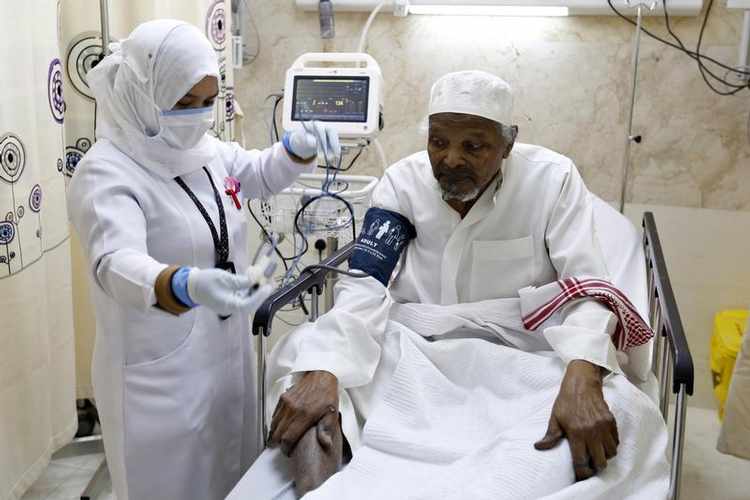With temperatures rising to some 45 degrees, hujjaj this year are said to have experienced a challenging haj. Dr Salim Parker, well known as South Africa’s hajj doctor, says that given the fact that hujjaj maintain a mind-set that allows them to tolerate the heat, most South African hujjaj remained unperturbed by the soaring desert temperatures, which ranged between 40 and 50 degrees Celsius.
“The passion and the spiritual upliftment of it was very encouraging. I think most people had a very uplifting hajj, however there were challenges,” he told VOC’s Burning Issue during a special show on Hajj 2017.
Parker adds that the humidity within the holy lands posed a further obstacle, where it reached 75 per cent at times.
Negotiating the heat
Given increased education that focuses on methods to deal with the temperatures experienced in the Kingdom, he says that most people suffered from heat exhaustion rather than heat strokes.
“If the temperature goes over 40 degrees [Celsius] and the humidity goes up to 75 [per cent]your body’s ability to adjust starts deteriorating. Yes, you will sweat, yes your body will vasodilate – the blood vessels become wider so that you can get rid of more heat, you sweat more profusely – but you don’t do enough of it.”
Despite well-coordinated classes by the Islamic Medical Association for hujjaj to learn tools to prevent heat exhaustion, Dr Parker said many hujjaj found acclimatizing to the heat very difficult.
“But yet when you there sometimes you can’t escape that and we literally had people collapsing in the tents on Mina and on Arafah when things did not go according to plan,” he stated.
Special services camps
Parker notes that while special services were in place, a number of logistical issues created a climate of unease for a number hujjaj.
“In the so-called special services where I was the operating doctor, we went there the morning and there were brand new air conditioners provided, but there were no plugs with it – there were just wires. So, all the operators got together and got plugs, [but]then there were not enough power points. So, you can have all the facilities in the world, but if it is not working it’s not really going to help,” he said.
Other factors he says included the incorrect allocation of camps, a problem he says lays at the helm of the Saudi counterparts and not South African Hajj and Umrah Council (SAHUC).
Parker asserts that the management of the various sites needs to be carefully addressed, so as to avoid inconveniencing hujjaaj who pay for special services.
“We have to relook at how we approach [the concerns]so that when the hujjaj arrives, everything is in place. Remember the hujjaj pay for their tannazzul, whether they are on special services or not.”
Despite problems such as a lack of plug points that has in previous year been tabled, Parker says that unique to the 2017/1438 hajj year, in Arafah on the special services camps there was no water after 16h00 and within the normal camps there was no water after 15h00.
“These are basic services that affect people’s health.”
Parker recalls an incident last year in which an electricity outage resulted in hujjaj collapsing in their tents on Arafah.
“I had a similar story last year, where we had the best of tents on Arafah, the special fibreglass incrusted tents. If the aircon worked it was absolutely brilliant. But, then there was a major electricity [outage]. These tents cannot open along the sides, so the temperature inside the tents went up to 55 degrees.”
Given the logistical scale of hajj, he says that while unexpected events accompany a journey of this nature, both Saudi and South African authorities need to step up and ensure that the health concerns of hujjaj are prioritised.
Listen to the full interview here:
Advice for hujjaaj to combat heat related illnesses
With increased concern around the physical nature of hajj, hujjaaj need to begin exercising well in advance prior to embarking on the journey.
“There is nothing better than having the spiritual benefits of haj accentuated by your physical fitness.”
In addition, he says that while it is understandable that hujjaj envisage completing as many umrah’s during their stay in Makkah, pilgrims need to ensure that they conserve their energies for the actual days of hajj.
With regards to medical cases he witnessed amongst hujjaaj, Parker says that chronic medical conditions appear to be on the increase.
“We normally know that people with high blood pressure, because they are physically more active, their blood pressure tends to be well controlled, but this year it went ‘haywire’. Our suspicion is that because it was so hot people consumed much more liquids, but it was mostly not pure water and it tended to be juices.”
Hujjaj with disabilities
With regards to individuals who are physically challenged, he states that for each group of 50 hujjaaj operators are accompanied by one assistant. Therefore, the assistant seeing to one individual removes his/her attention from 49 other hujjaaj, which Parker says is not the fault of the agent, but instead speaks to the need for the system to be reworked.
While there does exist adequate facilities for hujjaj who require physical assistance, this comes at a cost.
“On the day after Arafah, people were charging SR 300 to push a person in a wheelchair for tawaaf and saa’i. In the groups there are always people that are willing to push, but it’s sometimes the numbers are quite disproportionate.”
This is a concern that Parker says should be dealt with by all stakeholders. VOC






 WhatsApp us
WhatsApp us 

